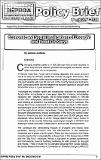| dc.date.accessioned | 2021-05-06T11:56:24Z | |
| dc.date.available | 2021-05-06T11:56:24Z | |
| dc.date.issued | 2018 | |
| dc.identifier.uri | http://repository.kippra.or.ke/handle/123456789/2923 | |
| dc.description.abstract | Changing weather patterns in Sub-Saharan Africa have resulted to
more frequent and intense episodes of droughts and floods, which
often culminate into emergencies.
In Kenya, more than 70 per cent of natural disasters that occur are as a
result of extreme climatic events that include droughts and floods. The
geographical position of the country makes it highly vulnerable to climateinduced
hazards with over 80 per cent of the country being arid and semiarid.
Some parts of the country experience double hazards of drought and
floods that occur in quick succession. The coverage and devastating impacts of droughts and floods have persisted, raising concerns over the effectiveness of the resilience
measures put in place over the years. There are also concerns that these
impacts may further complicate the achievement of the Kenya Vision 2030
and the "Big Four" initiatives. | en |
| dc.language.iso | en | en |
| dc.publisher | The Kenya Institute for Public Policy Research and Analysis | en |
| dc.relation.ispartofseries | PB/50/2018/2019; | |
| dc.subject | Climate change | en |
| dc.subject | Economic implications | en |
| dc.subject | Disaster management | en |
| dc.subject | Risk mitigation | en |
| dc.title | Policy Brief No. 50 of 2018-2019 on Economic and Social Implications of Drought and Floods in Kenya | en |
| dc.type | KIPPRA Publications | en |
| ppr.contributor.author | Laichena, Joshua | |

